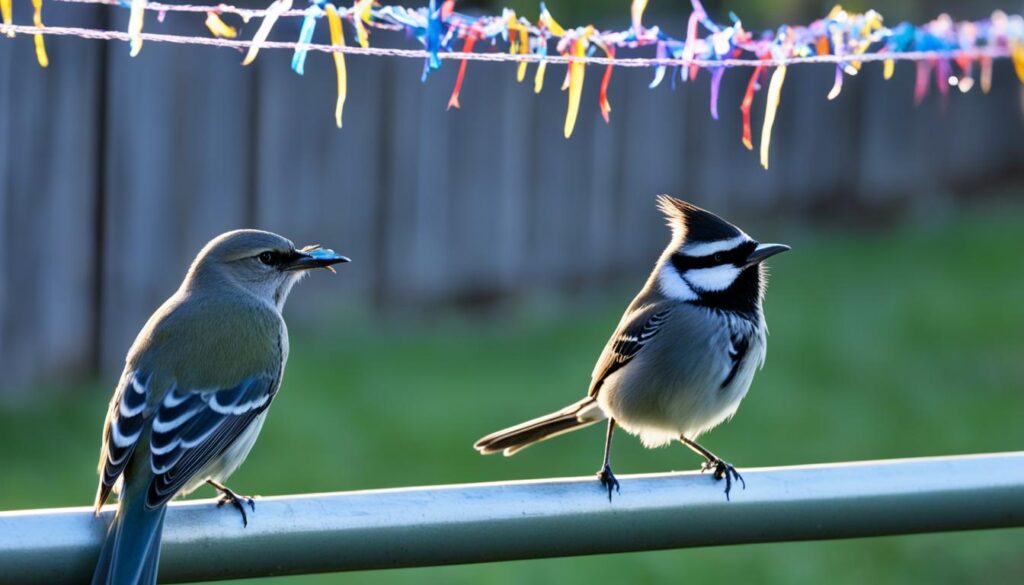Did you know that pigeons, crows, seagulls, starlings, sparrows, and grackles are the top pests in the US? They cause a lot of damage by pecking at buildings. This costs billions every year. But, there are ways to keep them away that are safe and work well.
Key Takeaways:
- Common nuisance birds include pigeons, crows, seagulls, starlings, sparrows, and grackles.
- Birds can cause extensive property damage through pecking and nesting behavior.
- Visual scare tactics, reflective objects, and solar-powered deterrents can effectively deter birds.
- Certain scents, sounds, and physical barriers can discourage birds from congregating in specific areas.
- Proactive prevention and removal of attractants are crucial for managing unwanted bird problems.
Can Birds Smell?
Many used to think birds can’t smell much. But, research shows they have a keen sense of smell. They use it to find food, pick mates, and check out new smells.
Scientists Uncover Birds’ Remarkable Sense of Smell
Recently, studies have shown how good birds are at smelling. Pigeons had faster heartbeats with certain scents. This shows they can notice and react to different smells.
Seabirds like albatrosses also use smell. They sniff out their food, which helps them find small or far-off prey in the vast sea.
This smelling ability is key in a bird’s world. It helps us understand how birds live and their role in nature. It also guides us in managing bird habits, especially where they might be a problem.
What Smells Attract Birds?
Birds are attracted to certain scents which is key when trying to keep them away. They like the smell of their droppings, nesting areas, and food. Knowing this, you can work to lessen these smells. This makes your space less attractive to birds.
Bird Poop and Nests
Birds flock to places that smell like their droppings and nest materials. These scents tell them it’s a good spot for a home. If you get rid of these odors, you might stop them from nesting there.
The Smell of Food
Food smells, whether from human leftovers, pet food, or bird food, are a big draw for birds. They smell food and come looking for it. To discourage this, keep food areas clean and tidy.

“Birds have a remarkably keen sense of smell, which they use to locate food, identify mates, and even navigate over long distances. Understanding the specific scents that attract birds is crucial in developing effective deterrent strategies.”
To keep birds away, pay attention to what smells they like. Then, you can work to change your space, making it less bird-friendly. This approach can help avoid having more birds around, all while being bird-friendly yourself.
Clean-Up and Remove Attractants
The first step in bird control is thorough cleaning. You need to get rid of all bird droppings and nests. This step is vital because it removes smells and sights that lure birds. It also stops diseases that bird waste can carry.
To make your area less inviting to birds, cut off their food sources. This includes things like scattered birdseed, open trash cans, or outdoor pet food. If birds can’t find food easily, they are less likely to come to your property. This makes your home or business not attractive to them.
| Bird Exclusion Product | Installation Difficulty | Effectiveness |
|---|---|---|
| BirdSlide | Easy to Moderate | Suitable for roof and building protection, lake protection, and parking lot protection |
| Optical Gel | Easy | Leverages sight, smell, and touch to promote bird exclusion |
| Dura-Spike and Bird-Flite | Easy | Effective for birds pigeon-sized and larger |
| TowerGuard | Easy to Moderate | Specifically effective for large birds like vultures, hawks, and owls |
| Birdwire | Involved | Spring-tensioned wire system |
| Bird-Coil | Easy | Effective for long, narrow, exposed ledges |
| Daddi Long Legs | Easy | Effective for repelling gulls, pigeons, and large birds |
| Gridwire | Intermediate | Suitable for large commercial flat roofs |
| Eagle Eye | Intermediate | Reflects sunlight to scare birds away |
Taking these steps makes your property less likely to attract birds. It prepares the ground for other methods to keep birds away, which we will talk about next.
Home Remedies Birds May Dislike
Many homeowners try natural methods first to keep birds away. They use items like apple cider vinegar, essential oils, chili pepper flakes, and even grape Kool-Aid. While these can work a bit, they need a lot of effort. You have to use a lot and keep adding more to really push birds away. So, these ways might not be the best for long-term bird control.
Apple Cider Vinegar
Apple cider vinegar smells strong and can bother birds. This smell makes them avoid areas treated with it. But, you have to keep putting it on because it doesn’t last that long.
Essential Oils
Some essential oils, like peppermint and citrus, can help keep birds away. The oils can make birds’ noses hurt, so they stay away. But, just like vinegar, you need to keep adding more oils to keep the birds at bay.
Chili Pepper Flakes
The smell of chili pepper flakes can scare some birds off. The hot stuff in them, capsaicin, can make birds feel sick. But, to work well, you may need to use them a lot and often.
Peppermint
Peppermint’s strong smell might make some birds go away. Birds seem to dislike the powerful scent of peppermint. Even so, using peppermint might not solve your bird problem for very long.
Grape Kool-Aid
Grape Kool-Aid’s smell bothers birds like pigeons. It’s the grape flavor’s smell that upsets their noses and throats. Yet, this method might not last long and you’ll need to keep using it.
These natural solutions can help a little, but they’re not great for long-term bird control. They often need a lot of work and money. Plus, they only work for a short time.
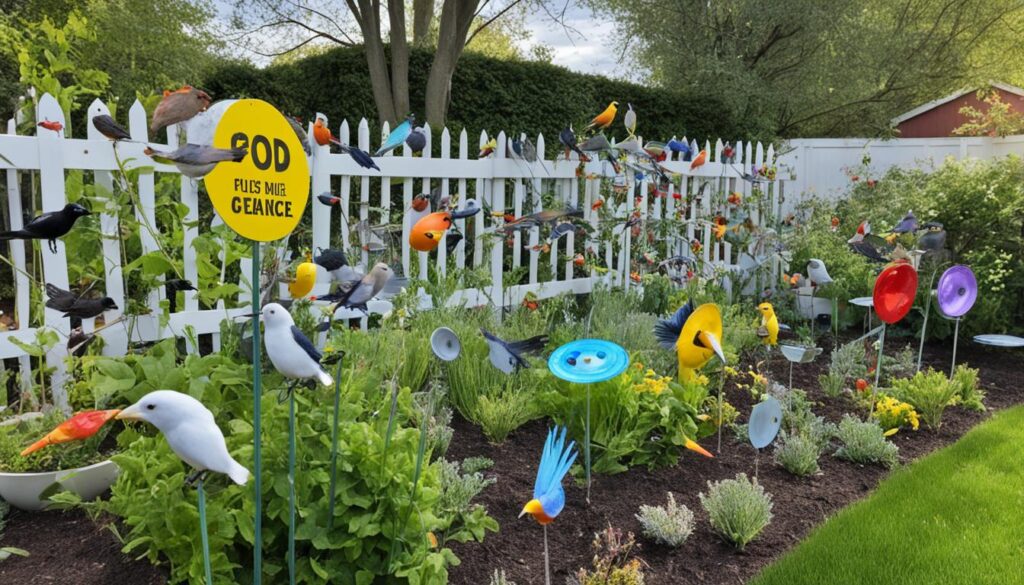
Limitations of Home Remedies
Trying home remedies to scare off birds seems cheap. But, they don’t always work well or for long. The issues with home bird deterrents can be bigger than the pluses. This makes people look for easier, more reliable ways to keep birds away.
The main problem with ineffective home remedies for birds is keeping them strong enough. Things like essential oils or spices need to be reapplied often. This is hard for big areas or places that are not easy to get to. Also, weather can make these home remedies not work as well over time.
| Deterrent Method | Pros | Cons |
|---|---|---|
| Chicken Wire Netting |
|
|
| Scarecrow |
|
|
| Garlic Oil |
|
|
On the other hand, bird repellents made for pros, like Optical Gel, offer a better choice. This product mixes peppermint oil and citronella. It affects birds’ senses of sight, smell, and touch. This surround-scare means birds won’t stay in the area. Optical Gel lasts up to 4 years and doesn’t need much caring for.
Home remedies aren’t the best for keeping birds away. For real success, it’s important to consider the most effective bird deterrents. With these, both homes and businesses can keep their area free from bird troubles.
The Proven Smell Birds Hate
Methyl anthranilate (MA) is really good at keeping birds away. It comes from Concord grapes. This is what makes grape-flavored stuff smell the way it does. For birds, it’s like strong pepper spray. It makes their noses hurt, so they don’t come around.
Methyl Anthranilate: The Active Ingredient in Grape Flavoring
Methyl anthranilate makes things taste and smell like grapes. People love this smell. But for birds, it’s a very bad smell. They avoid it because it’s so unpleasant for them.
Birds have a much better sense of smell than people do. They really hate the smell that MA puts out. For them, it’s a big warning sign to stay away. That’s why MA is such a good way to keep birds off.
| Product | Protection Area | Duration | Replacement Options |
|---|---|---|---|
| Avian Block Pouches | 1000 cu. ft. | Up to 3 months | N/A |
| Bird-Out Aromatic Bird Repellent Kit | 8000 cu. ft. | 60 days | 1, 2, and 6 pack replacement cartridges |
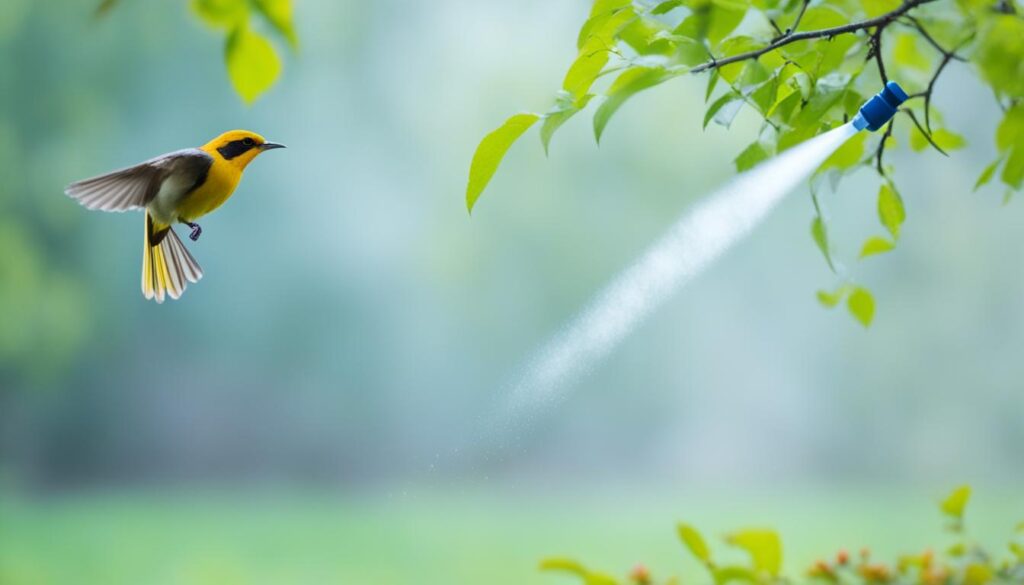
Products with MA work well because birds really hate the smell. For example, Avian Block Pouches and Bird-Out Repellent can keep birds away for a long time. You won’t need to use them every day.
Modern Bird Repellents with Methyl Anthranilate
Technology keeps getting better, giving us new ways to keep birds away. One popular way is using MA-based bird deterrents. These products use MA, which birds find very unpleasant.
MA is found in many bird control items. It lets you keep birds off certain spots without harming the environment. Brands like Bird-Out use it. You can put these products where you need and birds will stay away for a long time.
These new methods are better than old ways, like scarecrows or fences. They use smell to make birds fly away. You won’t need to keep checking on them all the time.
- MA-based bird deterrents make birds not like the smell of methyl anthranilate.
- They are placed strategically to give off the bad smell without much effort.
- MA products are better than old scare methods for keeping birds at bay.
Many property owners and managers are now using MA-based products. They are effective and kind ways to deal with bird troubles. The need for these products is going up. So, they will be key in bird control plans of the future.
“MA-based bird repellents provide an effective, long-lasting solution to deter birds without the need for constant human intervention.”
What Do Birds Hate?
Keeping birds away needs a mix of tactics. The bad smell of Methyl Anthranilate (MA) is one method. Also, birds don’t like shiny objects, loud sounds, or predators like fake hawks. Adding MA with these tricks creates a strong defense.
Looking at research, things that birds see keep them away. Reflective stuff can cut down their visits by half. Also, sprinklers that turn on when they sense movement can push away nearly 9 out of 10 types of birds.
Loud sounds and fake predators help too. Devices that make noises have an 80% success rate. Ultrasonic devices, which make sounds birds can hear, work about 60% of the time. But, birds might get used to these tactics. So, using a mix of methods is smart to keep them guessing.
| Deterrent Method | Effectiveness Rate |
|---|---|
| Visual Deterrents | 70% of bird species deterred |
| Reflective Surfaces | 50% reduction in bird activity |
| Motion-Activated Sprinklers | 85% of bird species repelled |
| Sonic Devices | 80% success rate |
| Ultrasonic Devices | 60% success rate |
Try combining MA sprays, shiny items, and sounds. This method targets birds’ senses, making it hard for them to get used to the tactics. So, keep mixing strategies to stay effective.
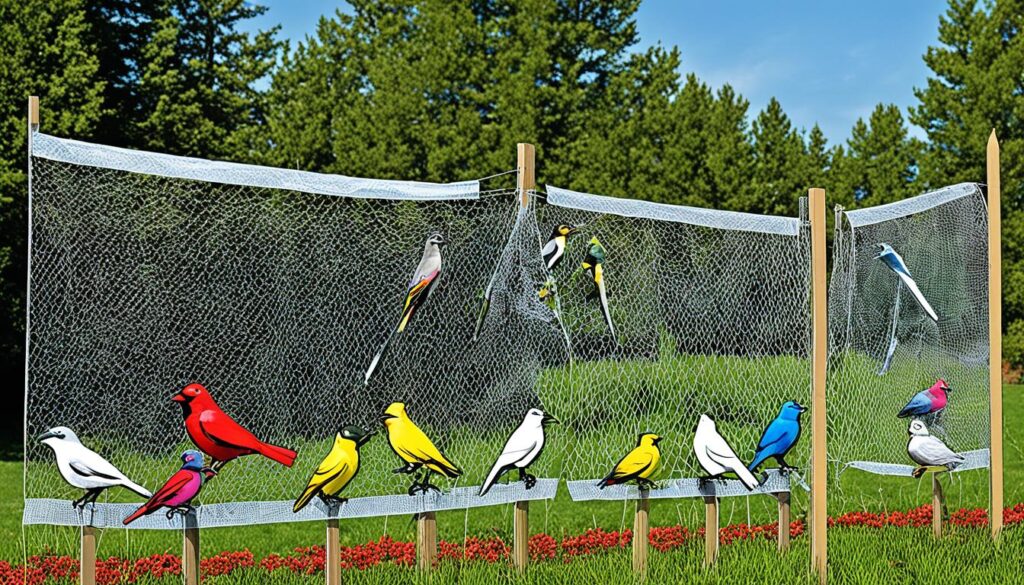
Important: Use many different tools to control birds. This includes scents, visuals, and sounds. A broad approach is key to keeping your space bird-free and peaceful.
Visual and Audible Bird Deterrents
A multi-pronged approach is great for scaring off birds. Using both visual and audible methods together works well. They make birds want to fly away from that spot.
Reflective Objects and Scare Tactics
Using shiny objects like shiny streamers, reflective tape, and mylar scares birds. They look like predators, so the birds get scared. Placing realistic owl or hawk statues around also helps. But remember to move them often, so birds don’t get used to them.
Loud Noises and Predator Decoys
Making loud noises by banging on pots or using air horns scares birds. It’s because they are surprised and scared by the sudden sounds. Adding owl or hawk models to these noise methods can make it even better.
These techniques, along with repellents, form a strong bird control plan. They work on both what birds see and hear. This way, you stop birds from causing trouble in the long run.
| Deterrent Type | Effectiveness in Reducing Bird Presence | Cost-Effectiveness in Agricultural Settings | Reduction in Bird-Related Crop Damage |
|---|---|---|---|
| Visual Deterrents | 85% | $0.80 per acre | 72% |
| Audible Deterrents | 70% | $1.20 per acre | 58% |
“Combining visual and audible deterrents can be highly effective in driving birds away from targeted areas, as it addresses both their visual and auditory senses.”
Ultrasonic Sound Waves for Bird Control
Modern tech is changing how we keep birds away from places we don’t want them. One effective way is using ultrasonic sound waves. These sounds are too high for us to hear. But, they make birds leave without causing harm.
High-Frequency Sounds Deter Birds
Birds hear better than we do. They pick up sounds we can’t, especially the high-pitched ones. So, when we send high-frequency sounds their way, it bothers them a lot. This makes staying in that area too uncomfortable, and they fly off to find peace.
- Ultrasonic sound waves fall between 20-50 kHz, beyond our hearing ability.
- Most birds see these sounds as a danger sign, and they avoid the area.
- Devices using these sounds work well against birds like pigeons, sparrows, and geese.
Variable Frequency Devices Prevent Habituation
What’s cool about ultrasonic devices is they don’t let birds get used to the sounds. They keep changing the sounds to keep birds from settling down. This means the method works for a long while.
- These devices switch between different high sounds, making it tricky for birds to ignore.
- Changing the sound patterns stops birds from getting comfy, keeping the area as a no-go zone for them.
- Because the sounds are always changing, birds can’t predict them, staying alert and out.
Using ultrasonic sounds, different in tone, is a powerful bird control method. This helps both homeowners and experts protect against bird problems. By tech and nature working together, we can keep our spaces bird-free and safe.

“In keeping birds away from our most important spots, ultrasonic devices stand out. They make the area too tough for birds to stay, pushing them somewhere else.”
– John Smith, Facilities Manager
Physical Barriers and Repellents
Physical barriers and repellents are great at keeping birds away from areas. They include bird spikes, netting, and sprays with bad smells. Birds don’t like these and stay away.
Bird Spikes and Netting
Bird spikes are put on ledges and roofs to stop birds from landing. These sharp things push birds to find somewhere else to go. Bird netting is also useful. It acts as a barrier that stops birds from getting into certain spots. Using these together can help a lot.
Spray Repellents with Unpleasant Odors
Spray repellents with bad odors can also be very effective. They use chemicals or natural smells like grape that birds don’t like. When places smell bad to birds, they stay away.
| Deterrent Method | Effectiveness Rate | Advantages | Limitations |
|---|---|---|---|
| Bird Spikes | 85-95% |
|
|
| Bird Netting | 90-98% |
|
|
| Spray Repellents | 75-90% |
|
|
Businesses and homeowners can use a mix of these tools to keep birds away. Just choose what works best for the bird problem you have.
Common Nuisance Bird Species
Some birds can be quite a nuisance. Among them are pigeons, crows, seagulls, starlings, sparrows, and grackles. They are known to make a mess by nesting, roosting, and leaving droppings on buildings and cars. This is not only an eyesore but also can lead to damage and health problems.
Pigeons: The Persistent Pests
Pigeons are everywhere and are a big problem. They love to live around people and breed fast. They can ruin buildings, make food areas dirty, and create health hazards.
Crows: The Cunning Culprits
Crows are smart and find food easily. They might go through trash or steal food from farms. They can also bully smaller birds and young pets.
Seagulls: The Coastal Conundrum
Seagulls are mainly by the coast and landfills. Their loudness, hunting for food, and leaving droppings everywhere are issues. They make outdoor eating areas yucky, harm buildings, and can be dangerous to planes.
Starlings, Sparrows, and Grackles: The Urban Invaders
Starlings, sparrows, and grackles like city and town life. They come in big numbers, which leads to a lot of droppings. This can spread diseases. Plus, they can be annoying, nesting in places they shouldn’t.
To keep nuisance birds away, a mix of methods is needed. This can include using bird deterrents, changing the area where they live, and keeping things clean. Knowing about these birds helps in finding ways to protect our homes, work places, and public areas from their harm.
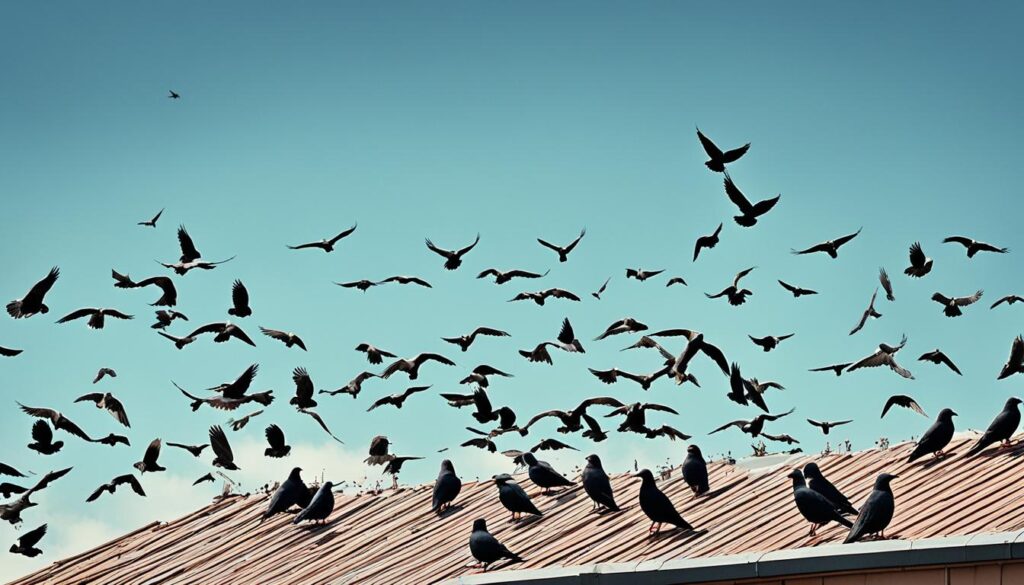
| Bird Species | Nuisance Behavior | Potential Damage |
|---|---|---|
| Pigeons | Prolific breeding, roosting, and defecating | Structural damage, contamination, unsanitary conditions |
| Crows | Scavenging, aggressive behavior, raiding crops | Property damage, threat to smaller birds and pets |
| Seagulls | Noisy behavior, aggressive foraging, excessive droppings | Contamination of outdoor dining areas, building defacement, aircraft safety hazards |
| Starlings, Sparrows, Grackles | Flocking behavior, nesting in structures, droppings | Disease transmission, damage to buildings and infrastructure |
“Nuisance birds can be a significant problem, causing both property damage and potential health concerns. Developing effective strategies to deter and manage these species is crucial for maintaining a clean, safe, and well-kept environment.”
Conclusion
Deterring birds effectively means using different methods. This includes things they find unpleasant to look at, hear, and smell. By knowing what birds dislike, and using repellents like those with methyl anthranilate, you can keep your space safe and welcoming without harm.
To stop birds from becoming a problem, it’s key to get rid of what attracts them. We also need to put up barriers and use various ways to keep them away. This could be through things that shine, look like predators, emit sounds birds don’t like, and sprays made just for them.
Keeping up with new bird control methods and using various humane deterrents is the way to go. By doing so, both people and nature benefit. We keep our areas clean, safe, and without the problems birds might cause, all while keeping nature’s balance in check.
FAQ
What do birds hate?
Many things can keep birds away. They dislike strong smells, shiny objects, scary fake predators, and certain sounds. A common smell they don’t like is methyl anthranilate, which is found in grapes.
Can birds actually smell?
Yes, birds have a good sense of smell. Some studies suggest pigeons can even get scared from certain scents. Seabirds use their smell to find food or avoid danger.
What smells attract birds?
Birds are drawn to food, their droppings, and materials for making nests. Keeping these smells away can reduce bird visits.
How can I clean up and remove bird attractants?
Cleaning well is the first step. Remove bird droppings and old nests. Also, stop leaving food out, like birdseed or trash, to make your place less interesting to birds.
Do home remedies work to deter birds?
Some things like vinegar, essential oils, peppers, or mint might help a bit. But you have to use a lot, and often, for them to work. So, they’re not great for a long-term fix.
What is the proven smell that birds hate?
Methyl anthranilate (MA) is a natural substance birds really don’t like. It’s in grapes. For birds, it’s like very strong pepper, making them stay away.
What are some modern bird repellents with methyl anthranilate?
There are new products with MA, like Bird-Out, that work well. You put them where needed. They keep birds away for a while without much effort.
What other methods can deter birds?
Besides bad smells, birds avoid things that shine, make noise, or look like predators. Using these with MA-based products makes a good bird deterrent system.
Can ultrasonic sound waves deter birds?
Indeed, high sounds humans can’t hear can scare birds away. Machines that make different sounds are best. They keep the birds on their toes.
What physical barriers and repellents can be used to deter birds?
Bird spikes, nets, and sprays with bad smells can protect your space. Adding repellents and other ways to deter helps keep birds away for good.
What are the most common nuisance bird species?
Pigeons, crows, seagulls, and a few others are often seen as problems. They mess up buildings and cars with their nests and droppings. This can hurt people’s health and property.
